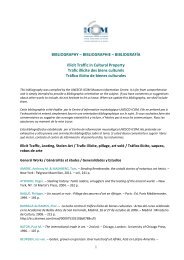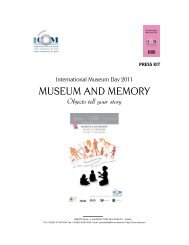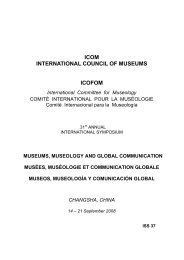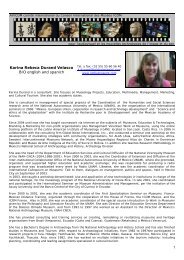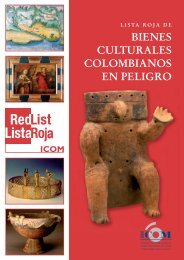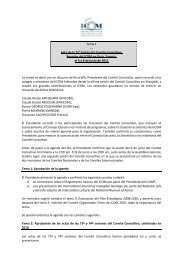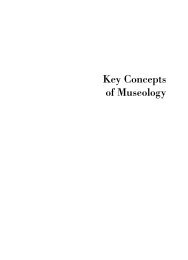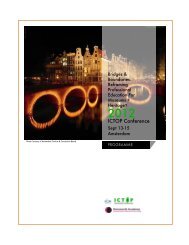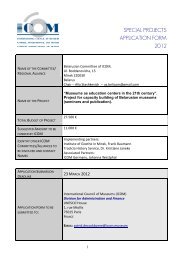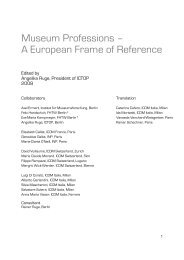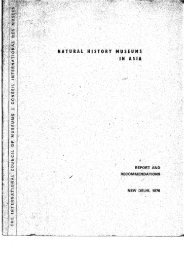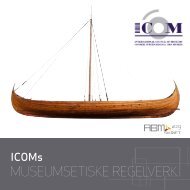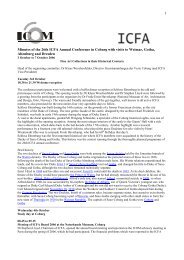ISS 25 (1995).pdf - The International Council of Museums
ISS 25 (1995).pdf - The International Council of Museums
ISS 25 (1995).pdf - The International Council of Museums
You also want an ePaper? Increase the reach of your titles
YUMPU automatically turns print PDFs into web optimized ePapers that Google loves.
to promote communication and education, privileging participative methodologies<br />
which, in turn, develop community critical awareness, where unity and diversity<br />
act as genuine expressions <strong>of</strong> universality.<br />
<strong>The</strong> community museum stems from the community's own needs and interests.<br />
As determinants <strong>of</strong> new methods and objectives, community initiatives and<br />
development link a territory with a heritage - through elements which represent<br />
nature and mankind's creativity - within a geographically limited local population<br />
which is in turn subject and actor <strong>of</strong> its own culture.<br />
<strong>The</strong>y constitute the conjunction <strong>of</strong> actions for favouring social, cultural and<br />
economic progress <strong>of</strong> each community; voluntary, desired development,<br />
implemented and criticized by its own members, both individually and collectively.<br />
As Hugues de Varine says "the natural community framework is a concentric<br />
space which successively involves the family, the pr<strong>of</strong>essional environment, the<br />
neighbourhood or village, the city or province and finally the region".<br />
At this point, imaginary spaces must be taken into account. Although<br />
immaterial, these are the spaces <strong>of</strong> creation and emotion which, together with<br />
intelligence, allow to reach total knowledge. What is peculiar about man is his<br />
spirit and it is this spirit which gets to know reality and which apprehends and<br />
updates values. His memory locates the events he recalls in terms which<br />
presuppose an abstract, general time; it is symbolic because it does not only<br />
revive past experiences, but instead rebuilds them. Achieved throughout a<br />
complex, arduous intellectual process, only man has that idea <strong>of</strong> abstract,<br />
geometric space. It is man who creates culture, uses it in several ways and grows<br />
and develops under its protection, constituting thus an undissolvable unit. Heir <strong>of</strong><br />
his past, <strong>of</strong> a series <strong>of</strong> bygone experiences which condition it, his distinctive<br />
feature is still his work.<br />
Conditioned by symbolic thought and the pertinent behaviours, the<br />
progress <strong>of</strong> culture and the continuity in the cultural development <strong>of</strong> communities<br />
is the basis <strong>of</strong> the future.<br />
After UNESCO's Fifth Regional Seminar in Mexico in 196i , the museum<br />
was considered the community's cultural centre which • ... must complete and assess<br />
the education system and perform an integration function aimed at the unity,<br />
preservation, analysis, interpretation, conservation and presentation <strong>of</strong> the community's<br />
cultural heritage and natural realities '.<br />
<strong>The</strong> community, that heterogeneous social group, joined by traditions,<br />
needs and solidarity, placed within a spatial and temporal framework. Community<br />
, UNESCO's Fifth Regional Seminar ''<strong>The</strong> museum as the cuffural centre <strong>of</strong> the community",<br />
Mexico, October 1962.<br />
39



